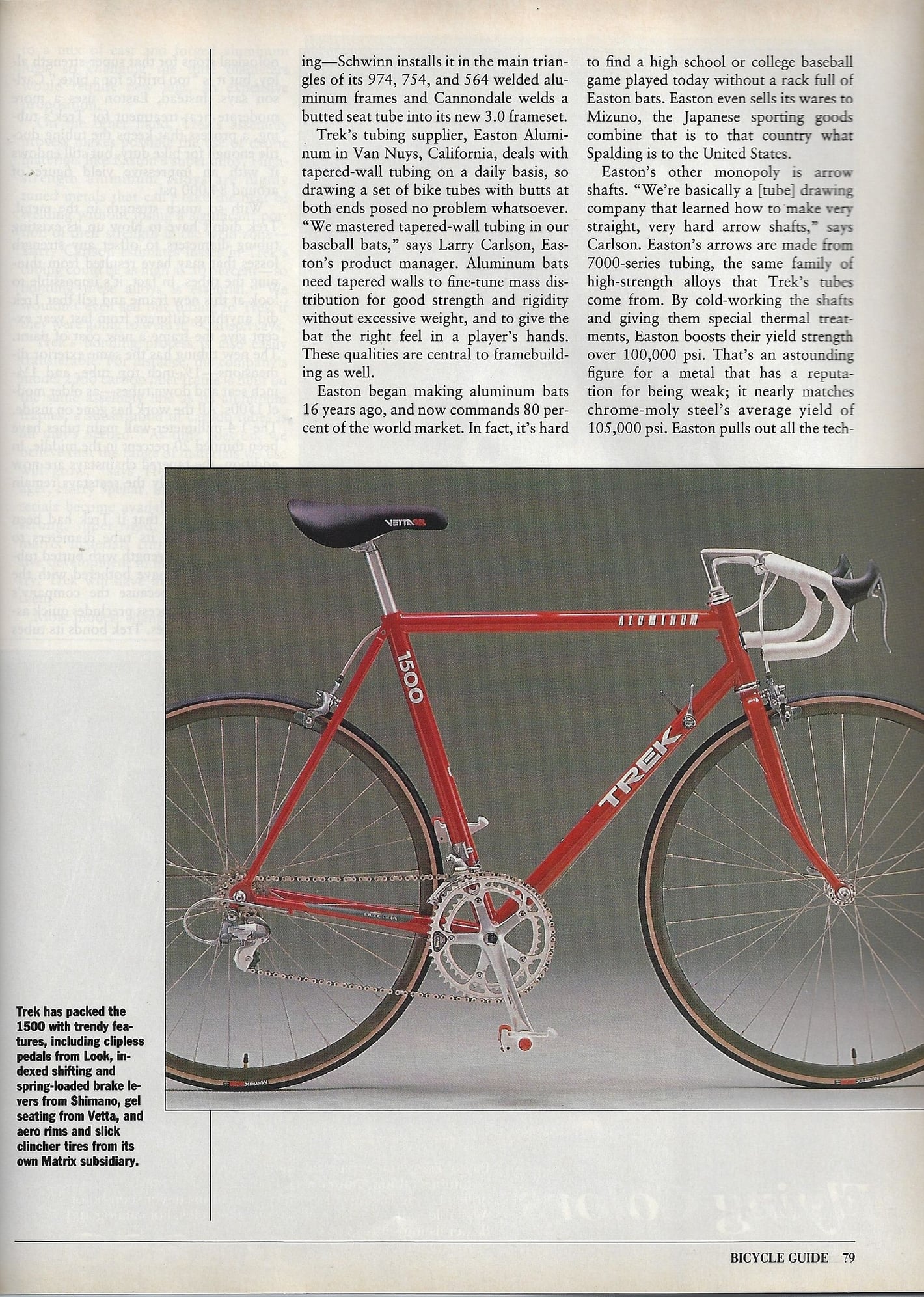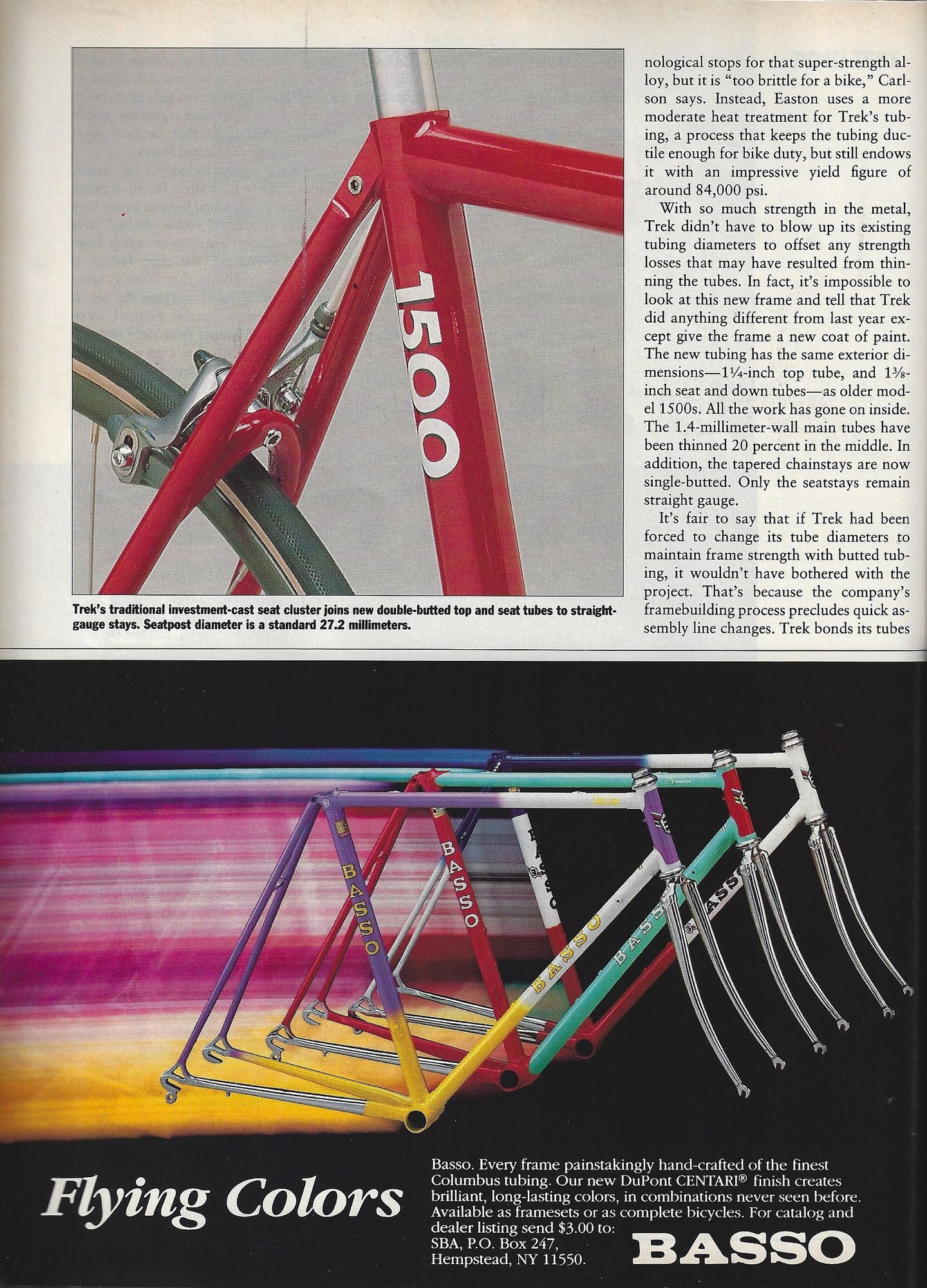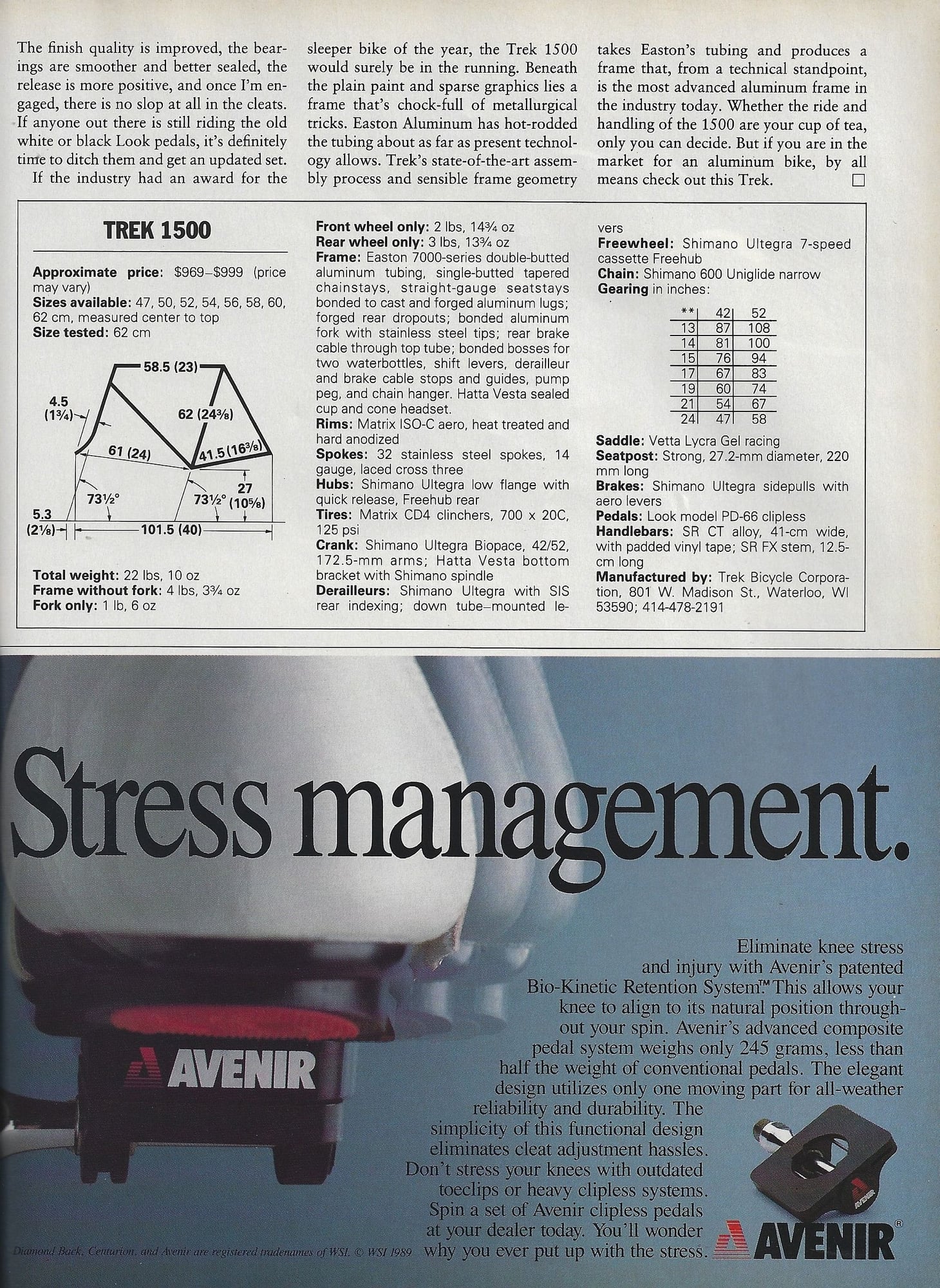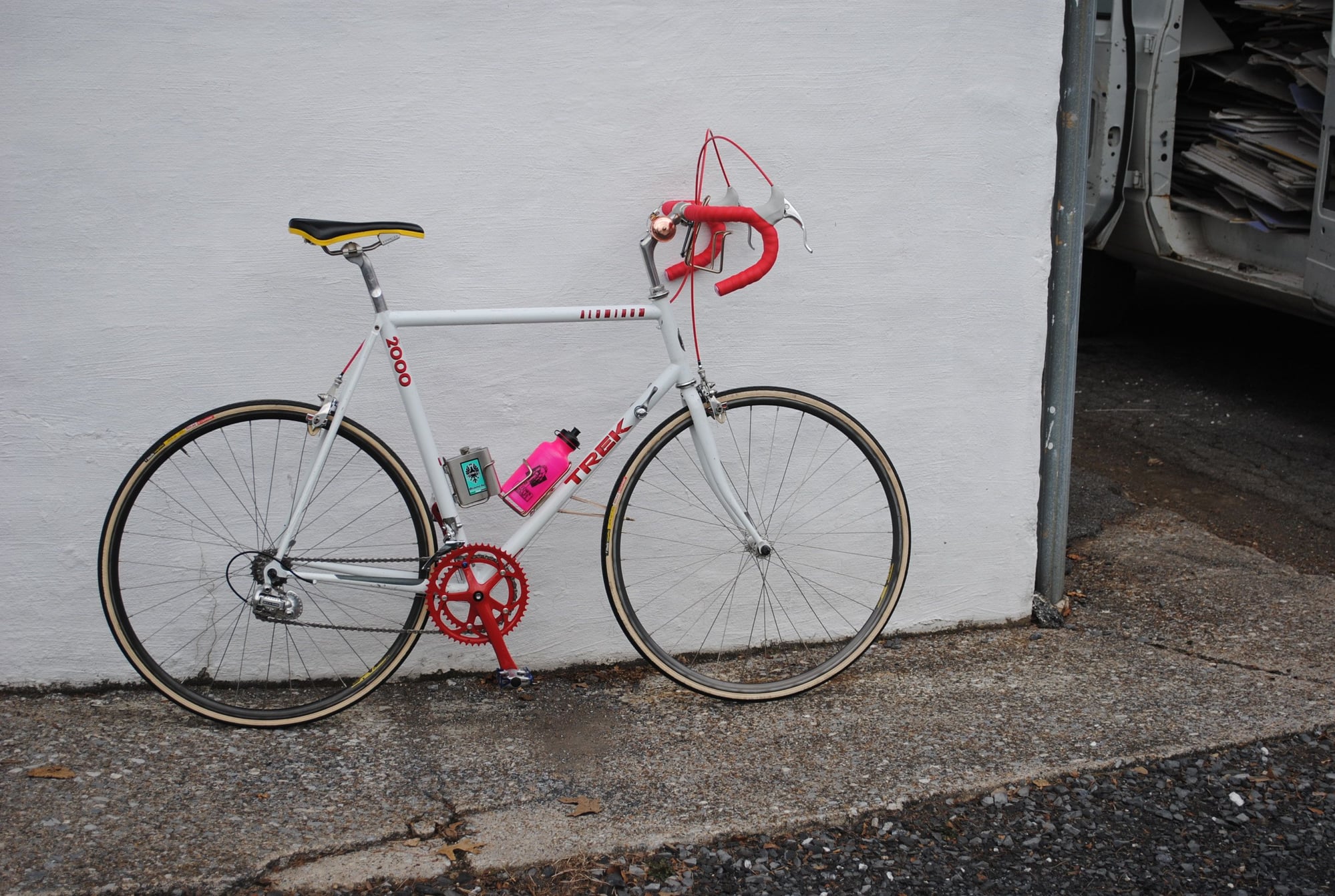Road Test/Bike Review (1989) TREK 1500
#1
Senior Member
Thread Starter
Join Date: Aug 2010
Location: Central Florida, USA
Posts: 1,991
Bikes: Litespeed (9); Slingshot (9); Specialized (3); Kestrel (2); Cervelo (1); FELT (1); Trek (2)
Mentioned: 39 Post(s)
Tagged: 0 Thread(s)
Quoted: 436 Post(s)
Liked 3,471 Times
in
999 Posts
Road Test/Bike Review (1989) TREK 1500






__________________
WTB: Slingshot bicycle promotional documents (catalog, pamphlets, etc).
WTB: American Cycling May - Aug, Oct, Dec 1966.
WTB: Bicycle Guide issues 1984 (any); Jun 1987; Jul, Nov/Dec 1992; Apr 1994; 1996 -1998 (any)
WTB: Bike World issue Jun 1974.
WTB: Slingshot bicycle promotional documents (catalog, pamphlets, etc).
WTB: American Cycling May - Aug, Oct, Dec 1966.
WTB: Bicycle Guide issues 1984 (any); Jun 1987; Jul, Nov/Dec 1992; Apr 1994; 1996 -1998 (any)
WTB: Bike World issue Jun 1974.
#2
Steel is real
Join Date: Mar 2013
Location: Not far from Paris
Posts: 1,957
Bikes: 1992Giant Tourer,1992MeridaAlbon,1996Scapin,1998KonaKilaueua,1993Peugeot Prestige,1991RaleighTeamZ(to be upgraded),1998 Jamis Dragon,1992CTWallis(to be built),1998VettaTeam(to be built),1995Coppi(to be built),1993Grandis(to be built)
Mentioned: 2 Post(s)
Tagged: 0 Thread(s)
Quoted: 670 Post(s)
Liked 977 Times
in
648 Posts
Very good bike  I am pretty sure that with a modern groupset and a modern pair wheels , it should be a lightweight
I am pretty sure that with a modern groupset and a modern pair wheels , it should be a lightweight
 I am pretty sure that with a modern groupset and a modern pair wheels , it should be a lightweight
I am pretty sure that with a modern groupset and a modern pair wheels , it should be a lightweight
#3
Standard Member
Join Date: Apr 2009
Location: Brunswick, Maine
Posts: 4,272
Bikes: 1948 P. Barnard & Son, 1962 Rudge Sports, 1963 Freddie Grubb Routier, 1980 Manufrance Hirondelle, 1983 F. Moser Sprint, 1989 Raleigh Technium Pre, 2001 Raleigh M80
Mentioned: 26 Post(s)
Tagged: 0 Thread(s)
Quoted: 1297 Post(s)
Liked 940 Times
in
490 Posts
From a marketing viewpoint, I don't know why TREK decided to give the 62cm size frame as the reference. If they had chosen a more popular size, like 54cm, they could have advertised a bicycle in perhaps the 19 lb. range. I like the fact that Easton was thinking ahead, but Spehar does not specify which size frame he is referring to when he said that the butting of the main-tubes reduces weight by 42.5 grams. It's all very nice, but is it just a gimmick to boost the price of the bicycle? The price of the bike is definitely in the high range for 1989. If I was going to pay anywhere near that much, I'd want a couple switches made by the L.B.S; give me a new freewheel with 13-26T, swap the inner chainring for a 39T and give me some tires with a 23mm width, like the other guy noted. I'd also like to know just how they joined the lugs and b.b. to the tubes and why they chose to make the lugs invisible (maybe I missed something in the article). Nice touch from TREK adding the high-quality pedals.
__________________
Unless you climb the rungs strategically, you’re not going to build the muscle you need to stay at the top.
Unless you climb the rungs strategically, you’re not going to build the muscle you need to stay at the top.
Last edited by 1989Pre; 11-11-23 at 07:39 AM.
#4
Bianchi Goddess
Join Date: Apr 2009
Location: Shady Pines Retirement Fort Wayne, In
Posts: 27,858
Bikes: Too many to list here check my signature.
Mentioned: 192 Post(s)
Tagged: 2 Thread(s)
Quoted: 2930 Post(s)
Liked 2,927 Times
in
1,492 Posts
I had one of those frames, at least I think it was the same one just a different model/year, it was OK nice and light but just felt like it had so soul and spirit.


__________________
“One morning you wake up, the girl is gone, the bikes are gone, all that's left behind is a pair of old tires and a tube of tubular glue, all squeezed out"
Sugar "Kane" Kowalczyk
“One morning you wake up, the girl is gone, the bikes are gone, all that's left behind is a pair of old tires and a tube of tubular glue, all squeezed out"
Sugar "Kane" Kowalczyk
#5
Senior Member
Join Date: Jan 2005
Location: Baltimore, MD
Posts: 5,374
Mentioned: 15 Post(s)
Tagged: 0 Thread(s)
Quoted: 2483 Post(s)
Liked 2,955 Times
in
1,678 Posts
From a marketing viewpoint, I don't know why TREK decided to give the 62cm size frame as the reference. If they had chosen a more popular size, like 54cm, they could have advertised a bicycle in perhaps the 19 lb. range. I like the fact that Easton was thinking ahead, but I am wondering exactly how much (if any) weight is saved by butting the tubes. It's all very nice, but is it just a gimmick to boost the price of the bicycle 200 dollars? The price of the bike is definitely in the high range for 1989. If I was going to pay anywhere near that much, I'd want a couple switches made by the L.B.S; give me a new freewheel with 13-26T, swap the inner chainring for a 39T and give me some tires with a 23mm width, instead.
A thousand bucks for a full Ultegra group and a bike that would have been among the lightest available for anywhere near that price seems reasonable to me.
Objecting to the $200 difference for butted aluminum tubing---that's quite a bit less of a difference than going from a plain-gauge steel Columbus or Reynolds tube set to a butted one would have been. As I recall, the butted steel frames often retailed for something like twice the cost of the unbutted frames.
As for the changes to the cluster range, chairing size, and tire width: you'd have had to make the same changes for any similar upper-mid-level steel racing bike. Was any racing bike of the era equipped with a cluster with a 26-tooth large sprocket? I don't remember any.
In any event, in the late '80's, it was very rare for customers buying off-the-shelf bikes to request any such changes to the stock setups. Such customers, in our shop at least, were buying Italian framesets and having us build them up with their preferred components.
#6
Senior Member
Join Date: Jan 2005
Location: Baltimore, MD
Posts: 5,374
Mentioned: 15 Post(s)
Tagged: 0 Thread(s)
Quoted: 2483 Post(s)
Liked 2,955 Times
in
1,678 Posts
Thinking back to working in the bike shop then, we found it mildly interesting that we were now selling aluminum racing bikes alongside steel ones. Didn't seem earth-shattering at the time.
Customers did like the idea of buying something new and different, and arguably state of the art, but some also liked the idea that they could buy a bike with a U.S.-built frame, and one whose tubing was made in the U.S., too: Easton aluminum for 1989, True Temper aluminum in later model years.
Sometime around 1991 or 1992 or so, I asked our Trek rep whether introducing the aluminum bikes had had any unforeseen consequences for the company. He said that the main one he knew about was that they didn't have to keep as many frames in stock for warranty replacement, compared to previous years when they were selling steel-frame bikes exclusively.
#7
Bianchi Goddess
Join Date: Apr 2009
Location: Shady Pines Retirement Fort Wayne, In
Posts: 27,858
Bikes: Too many to list here check my signature.
Mentioned: 192 Post(s)
Tagged: 2 Thread(s)
Quoted: 2930 Post(s)
Liked 2,927 Times
in
1,492 Posts
Sometime around 1991 or 1992 or so, I asked our Trek rep whether introducing the aluminum bikes had had any unforeseen consequences for the company. He said that the main one he knew about was that they didn't have to keep as many frames in stock for warranty replacement, compared to previous years when they were selling steel-frame bikes exclusively.
__________________
“One morning you wake up, the girl is gone, the bikes are gone, all that's left behind is a pair of old tires and a tube of tubular glue, all squeezed out"
Sugar "Kane" Kowalczyk
“One morning you wake up, the girl is gone, the bikes are gone, all that's left behind is a pair of old tires and a tube of tubular glue, all squeezed out"
Sugar "Kane" Kowalczyk
#8
Senior Member
Join Date: Jan 2005
Location: Baltimore, MD
Posts: 5,374
Mentioned: 15 Post(s)
Tagged: 0 Thread(s)
Quoted: 2483 Post(s)
Liked 2,955 Times
in
1,678 Posts
I've told this story before, but it's apropos here:
Sometime in the mid-'80's, a customer who had bought a Bianchi racing bike from us a year or so earlier brought it back with a crack across the top of a seat stay, at the seat cluster. The Bianchi rep stopped by a few days later to look at it and agreed---clearly a warranty issue. He called Bianchi USA and ordered the replacement frame.
I asked him, more or less idly, what was going to happen to the old frame: would Bianchi of Italy ship a free replacement sight unseen, or would he have to ship it to them first, or what?
He said, "Bianchi of Italy doesn't cover frames under warranty; Bianchi USA does."
By way of illustration, he went on to describe a scene he'd witnessed some time earlier, when some of the Italian Bianchi people visited Bianchi USA, in South San Francisco. One of the Italians was visiting Bianchi USA for the first time, so one of the other guys urged him to ask about Bianchi USA's warranty. He did, and the whole Italian contingent burst into laughter at the look on his face when he was told that Bianchi USA gave free replacement frames away under warranty.
The head Italian then told the Americans that, yes, we can sell you frames that we'd cover under warranty. "They'd just be one or two kilos heavier."
Likes For Trakhak:
#9
Bianchi Goddess
Join Date: Apr 2009
Location: Shady Pines Retirement Fort Wayne, In
Posts: 27,858
Bikes: Too many to list here check my signature.
Mentioned: 192 Post(s)
Tagged: 2 Thread(s)
Quoted: 2930 Post(s)
Liked 2,927 Times
in
1,492 Posts
@Trakhak Interesting. I've warrantied a few customer frames and even one of my own but I never realized Bianchi USA picked up the tab.
__________________
“One morning you wake up, the girl is gone, the bikes are gone, all that's left behind is a pair of old tires and a tube of tubular glue, all squeezed out"
Sugar "Kane" Kowalczyk
“One morning you wake up, the girl is gone, the bikes are gone, all that's left behind is a pair of old tires and a tube of tubular glue, all squeezed out"
Sugar "Kane" Kowalczyk
Likes For Bianchigirll:
#10
Standard Member
Join Date: Apr 2009
Location: Brunswick, Maine
Posts: 4,272
Bikes: 1948 P. Barnard & Son, 1962 Rudge Sports, 1963 Freddie Grubb Routier, 1980 Manufrance Hirondelle, 1983 F. Moser Sprint, 1989 Raleigh Technium Pre, 2001 Raleigh M80
Mentioned: 26 Post(s)
Tagged: 0 Thread(s)
Quoted: 1297 Post(s)
Liked 940 Times
in
490 Posts
I see what you are saying about "arguably state-of-the-art". While TREK was using 7000 series Easton, double butted, Raleigh USA was using slightly-oversized 6000 series (they did use T8, which I'll give them credit for) straight-guage. TREK also dodged a bullet by avoiding the Suntour indexing system and opting for Shimano. How well were the aluminum dropouts received? I would also like to ask (to anyone here), "Why did TREK go to a fork with a 45mm rake? The relatively-steep frame angles seems a strange combination with that. With 7-speed cassette, TREK was ahead of Raleigh USA in two ways in 1989.
__________________
Unless you climb the rungs strategically, you’re not going to build the muscle you need to stay at the top.
Unless you climb the rungs strategically, you’re not going to build the muscle you need to stay at the top.
Last edited by 1989Pre; 11-11-23 at 11:49 AM.
#11
Standard Member
Join Date: Apr 2009
Location: Brunswick, Maine
Posts: 4,272
Bikes: 1948 P. Barnard & Son, 1962 Rudge Sports, 1963 Freddie Grubb Routier, 1980 Manufrance Hirondelle, 1983 F. Moser Sprint, 1989 Raleigh Technium Pre, 2001 Raleigh M80
Mentioned: 26 Post(s)
Tagged: 0 Thread(s)
Quoted: 1297 Post(s)
Liked 940 Times
in
490 Posts
Bianchigirl, I know what you are saying about aluminum's ride characteristics, but that is just the price we pay for light weight. After my Technium got me through some really tough, long rides by it's light weight alone (compared with the weights of the rest of my road bikes), I found its soul and we understood eachother completely. It's the bike I whip out when it gets serious.
__________________
Unless you climb the rungs strategically, you’re not going to build the muscle you need to stay at the top.
Unless you climb the rungs strategically, you’re not going to build the muscle you need to stay at the top.
#12
Senior Member
Join Date: Jan 2005
Location: Baltimore, MD
Posts: 5,374
Mentioned: 15 Post(s)
Tagged: 0 Thread(s)
Quoted: 2483 Post(s)
Liked 2,955 Times
in
1,678 Posts
Aha. Thank you very much. Internal lugs. That's something that is something that I have not investigated. You have piqued my curiosity. Was it only the flux that held the lug to the tubing? The reason I ask is that, for comparison, Technium used three types of connection/retention on their steel lugs; Prior heating of the lugs, which shrunk and fastened onto the aluminum tubing when put in place 2.) a locking ring on the lug that "snapped" into place when the tubing was inserted and 3.) the flux, itself.
I see what you are saying about "arguably state-of-the-art". While TREK was using 7000 series Easton, double butted, Raleigh USA was using slightly-oversized 6000 series (they did use T8, which I'll give them credit for) straight-guage. TREK also dodged a bullet by avoiding the Suntour indexing system and opting for Shimano. How well were the aluminum dropouts received? I would also like to ask (to anyone here), "Why did TREK go to a fork with a 45mm rake? The relatively-steep frame angles seems a strange combination with that. With 7-speed cassette, TREK was ahead of Raleigh USA in two ways in 1989.
I see what you are saying about "arguably state-of-the-art". While TREK was using 7000 series Easton, double butted, Raleigh USA was using slightly-oversized 6000 series (they did use T8, which I'll give them credit for) straight-guage. TREK also dodged a bullet by avoiding the Suntour indexing system and opting for Shimano. How well were the aluminum dropouts received? I would also like to ask (to anyone here), "Why did TREK go to a fork with a 45mm rake? The relatively-steep frame angles seems a strange combination with that. With 7-speed cassette, TREK was ahead of Raleigh USA in two ways in 1989.
Which reminds me of another article, posted by SpeedOfLite several months ago, for which Trek provided two racing bikes, one with a steel frame and the other with the new aluminum frame. The bikes were otherwise identical: same components, wheels, tires, etc., and same steel fork for each.
All the reviewers who rode the two bikes raved about the aluminum bike---all of them preferred it to the steel bike, saying, among other things, that the aluminum bike was more comfortable on all road surfaces. One of the few criticisms offered in that article was that both bikes were a bit sluggish with respect to steering and would profit from having the front end or fork reconfigured for quicker handling. (They also said that Trek should upgrade the aluminum bike with an aluminum fork, incidentally.)
About the aluminum tube-joining process: I just looked through my copy of the Trek Retail Technical Manual from 1994.
Leafing through, I'm embarrassed to realize that I never bothered reading it back then. What I learned in the last 30 seconds:
The "new shifting systems" should not be subjected to "dry-firing"---i.e., operating the shift mechanism in the brake lever when the chain is not in motion (actually, I knew that, but I don't remember the term "dry-firing").
The mechanic should become adept at "side-actuated brake adjustment"---adjusting, that is the Interloc Racing Design Widget, which allowed the use of cantilever brakes with rigid and suspension bikes alike.
Same deal for Paul Component Engineering Cross-Tops.
And same deal for Trek's own BAUs (Brake Actuator Units).
They were already moving on from aluminum to OCLV, and they don't go into a lot of detail about the aluminum bonding method.
To the point: the only mention of the details of Trek's bonding process is in the section on the manufacturing of the OCLV frames, as follows (likely with some similarities to the aluminum bonding):
"Bonding is a process that uses aerospace adhesives to glue the lugs and tubes together, but this is no ordinary glue! Similar to the adhesives used to join airplane fuselages or hold helicopter rotor blades together, it would take 16 tons of force to pull two pieces of an OCLV frame apart. Actually, the material surrounding a bonded joint would give way before the bond could be broken."
So that's all I've got. I'm prepared to answer questions about those rear-suspension cantilever brake work-arounds, though.
Likes For Trakhak:
#13
Senior Member
Join Date: Jul 2020
Location: Humboldt County, CA
Posts: 832
Mentioned: 7 Post(s)
Tagged: 0 Thread(s)
Quoted: 405 Post(s)
Likes: 0
Liked 430 Times
in
286 Posts
And, yes, they used the same frame across all models. The only difference was the components. (Maybe in the years where they switched tubing, the lower models got the previous year's tubeset... not sure about that.)
--Shannon
Likes For ShannonM:
#14
Standard Member
Join Date: Apr 2009
Location: Brunswick, Maine
Posts: 4,272
Bikes: 1948 P. Barnard & Son, 1962 Rudge Sports, 1963 Freddie Grubb Routier, 1980 Manufrance Hirondelle, 1983 F. Moser Sprint, 1989 Raleigh Technium Pre, 2001 Raleigh M80
Mentioned: 26 Post(s)
Tagged: 0 Thread(s)
Quoted: 1297 Post(s)
Liked 940 Times
in
490 Posts
"Trail" is something that I have not researched, but probably should. I had assumed that a longer rake would provide some shock-dampening for the rider.
__________________
Unless you climb the rungs strategically, you’re not going to build the muscle you need to stay at the top.
Unless you climb the rungs strategically, you’re not going to build the muscle you need to stay at the top.
#15
Senior Member
Join Date: Jan 2005
Location: Baltimore, MD
Posts: 5,374
Mentioned: 15 Post(s)
Tagged: 0 Thread(s)
Quoted: 2483 Post(s)
Liked 2,955 Times
in
1,678 Posts
Interestingly, all the reviewers of the two bikes agreed that the aluminum-frame bike had a smoother, more comfortable ride than the steel bike but also said that both bikes would have benefited from a front-end geometry with less trail. Quoting from the article:
'Unfortunately, the 560 sports the same bland geometry as the 1200. If Trek had specified an aggressive head angle and tight wheelbase on the 560, the bike would hold a definite selling angle over its aluminum shadow. Instead, it rides with the same stretched-out balance as the 1200---a 39 5/8" wheelbase, 73-degree head angle and 2 3/8" of trail. Like the 1200, the 550 is a tad slow to steer, but tracks straight ahead and is stable at all speeds.'
Last edited by Trakhak; 11-12-23 at 05:57 AM.






